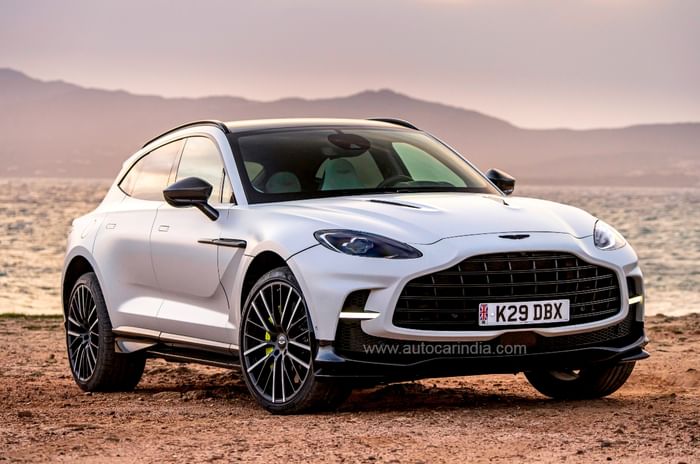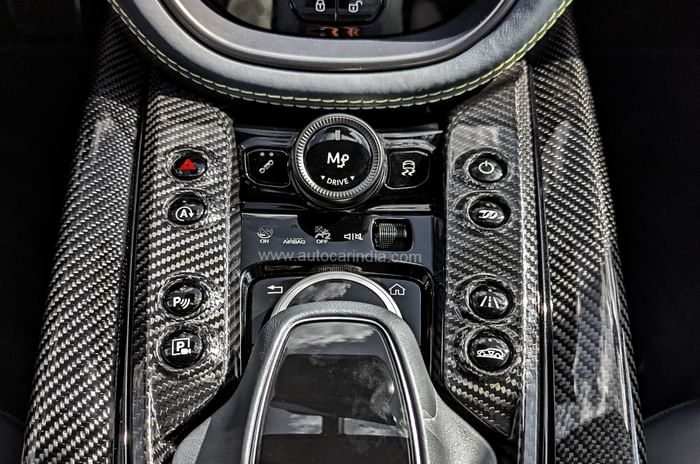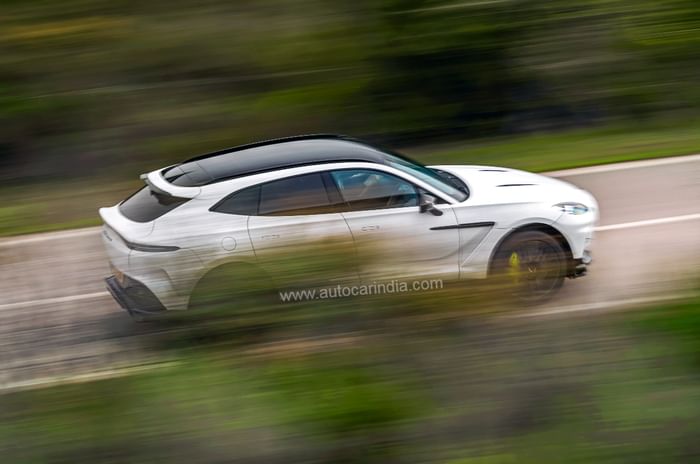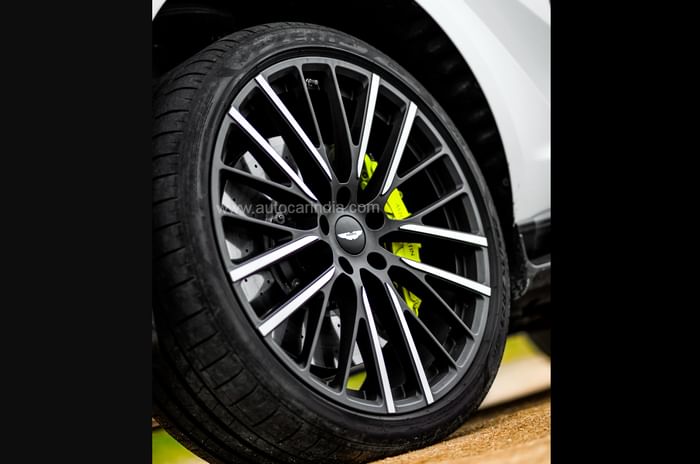It’s fair to admit that many of us misunderstood the original Aston Martin DBX up until this point. With its beautiful bodywork, twin-turbo V8, sophisticated chassis trickery to help it mask its size, bespoke and customisable interior, and high price it felt every bit the super SUV at the very peak of its game. Its 550hp and 700Nm outputs weren’t at the top of the class, sure, but as an overall package, it was positioned right up there with the best.
What we didn’t know then was that the DBX 550, as it’s called now, was only the base, and it’s really this new DBX 707 that was envisioned from day one to be Aston Martin’s true super-SUV. To put it into perspective, if the 550 was the BMW M340i of the DBX range, that would make the 707 the M3 Competition.

707 (pronounced seven-oh-seven) might sound like an allusion to everyone’s favourite fictional British spy and long-time Aston Martin brand ambassador, but that’s not the case. The SUV was simply named after the engine’s power figure, and not the other way around. That 707hp output, Aston says, makes this the most powerful ‘luxury SUV’ in the world right now, which is a clever way to steer clear of some other SUVs stuffed with a lot of power, but, perhaps, lack the premium appointments the DBX claims to offer.
Still, even with this caveat in place, the DBX 707 has its work cut out for it, vying for your crores against the likes of the Porsche Cayenne Turbo GT, Audi RS Q8, Maserati Levante GTS, Bentley Bentayga Speed, and perhaps, most crucially, the Lamborghini Urus. So where does it sit, and is it more than just a power bump? Read on.
Aston Martin DBX 707: exterior styling and changes
Arguably one of the most beautiful large SUVs around, the DBX gets a shot of aggression in its upgrade to 707. It’s 16mm wider in the rear track, giving it a squatter stance, there are wider side skirts and it rides on new, optional 23-inch wheels (285-section up front and 325 at the rear), which can also be specced on the 550 now. At the back, in addition to the roof spoiler and the brilliantly sculpted duck-tail tailgate, there’s now a huge diffuser undertray jutting out from the rear bumper – it’s large enough to serve drinks on!
The big changes, however, are up front, where the already huge Aston Martin grille has grown 27 percent larger; BMWs and Audis have nothing on this. This, along with new openings lower in the bumper, allows for 80 percent greater airflow, aiding not just downforce, but cooling too. There are more radiators to better temper the upgraded engine and gearbox, and more air is channelled into the wheel arches to cool the brakes too.

All in all, some of the elegance of the 550 has been sacrificed, but this still remains one of the sexiest SUVs out there. The almost exaggerated sculpting of the bodywork makes it seem quite compact, until you’re standing right next to it, of course, and despite its proportions, it wears its brand identity so boldly, you couldn’t mistake it for anything other than an Aston Martin.
Aston Martin DBX 707: interior styling, features and luxury
This is a cabin designed with an overtly sporty intent, especially specced as this one is in the Aston Martin Racing colours. The centre console has gotten a bit more crowded, but also more functional, with the addition of shortcut buttons for drive modes and a few other driver settings.
The screens have been carried over from the DBX too, and while the digital dials are good-looking and informative – if not as crisp as the very latest – it’s the main infotainment system that leaves a lot to be desired. It’s based on Mercedes’ two-generation-old system, which, in the context of today’s state-of-the-art interfaces, feels behind the times. It even relies on an old-fashioned touchpad for navigation, rather than a touchscreen. However, the team at Aston did hint that this was something that could be addressed with the facelift.
The 707 uses a new set of sports seats which offer a bit more lateral and shoulder support, and aren’t quite as soft and generously cushioned as the standard seats in the 550. They are still incredibly comfortable and would leave you relaxed at the end of a long journey.

Back to the AMR interior colour scheme though, and if that’s a bit too shouty for you, know that you can have it in a more-traditional ‘luxury car’ spec. Tan and black leather, rather than blue and green, and wood inlays rather than carbon fibre, for example. In fact, customers are encouraged to dive deep into the brand’s ‘Q’ customisation catalogue, with options ranging from the aforementioned colours and trim, to bespoke fitments that no other car will have.
There’s a tangible richness to everything in the cabin too, with soft leather, hand-stitched everything and an opulent design. And this, Aston says, is what sets it apart from most high-performance SUVs and allows it to also tempt people out of super-luxury SUVs.
Aston Martin DBX 707: engine, performance, ride and handling
What also sets it apart, according to Aston, is that while most other SUVs in this class are based on platforms originally designed to prioritise comfort and luxury, the DBX’s bespoke platform was engineered from day one to deliver a sports SUV first and foremost. And from there, to arrive at the 707, the changes had to be effected carefully so as to make the DBX more powerful and engaging, but without completely eliminating its long-distance GT cruising capabilities.
It’s why the front suspension mounts were stiffened, but the rear suspension was correspondingly softened. It’s why a little slack was left in the revised steering and the 48V active anti-roll bars – anything sharper would have felt too twitchy. It’s why the ride height and damper settings remain the same as the standard DBX in the basic GT mode, and were only lowered and stiffened in Sport and Sport+ modes.

They could have simply lumped the 5.2-litre twin-turbo V12 from the DBS Superleggera into the SUV and called it a day; the power output would have easily been met too. The reasons for sticking with the AMG-sourced 4.0-litre V8 are that its character is better suited to an SUV, and also because it saves considerable weight in what is already a heavy car.
To arrive at the swollen outputs of 707hp and 900Nm, there are new, more responsive ball-bearing turbochargers and an engine remap, and harnessing all this oomph is a wet-clutch version of AMG’s 9-speed automatic gearbox. There’s a beefier rear differential, which is fed power by a single-piece carbon fibre prop shaft that’s stronger and lighter, and a new exhaust system too.
The results are expectedly dramatic, and flooring it from part-throttle in Sport+ mode rockets you forward on a wave of g-forces and beautiful sound. Launching from a standstill gets you to 100kph in 3.3sec, and though this uses the full might of the AWD system, it can also, given the right driving scenario, send 100 percent of the power to the rear wheels. Turning the electronic safety aids off and booting it reveals signs of a willingness to oversteer; signs I was unwilling to pursue on the narrow mountain roads of Sardinia.

The DBX 550 was already one of the best handling SUVs we’d ever driven, and it’s been sharpened up ever so slightly for the 707. A bit more weight and speed in the steering, a bit less pitch and roll under braking and cornering, and frankly, there wasn’t much more that needed improving. This two-metre-wide, 2.3-tonne SUV has an uncanny ability to wrap itself around you, and keep you from wrapping it around the next light pole, with electronics that allow some deviance, yet rein you in at just the right moment, and quick enough responses to goad you on without scaring you.
The best part is that all the components – powertrain, chassis and electronics – feel cohesively interconnected in a way many of its rivals don’t, and it’s this holistic focus on an engaging drive that feels really special.
And still, all you have to do is switch it back down to GT mode to transform it into a relaxed cruiser. The three-chamber air suspension does a good job of ride quality – not soft and floaty like a full-on luxury car, but not harsh like a sportscar either. There’s an acceptable amount of firmness for a vehicle of this type, and one with ‘Aston Martin’ on its tailgate, but if comfort is the priority, we’d recommend sticking to the standard 22-inch wheels and not these optional 23-inch ones.

If there’s one component that doesn’t quite live up to the rest in the driving experience, it’s the gearbox. While it’s smooth and unobtrusive enough in GT mode, and shifts fast enough at full throttle in Sport+ mode, its responsiveness to your inputs in any of the modes can be a little slow at times.
Aston Martin DBX 707: expected price and verdict
With its more potent powertrain and chiselled handling, the DBX 707 casts a far wider net than the standard DBX 550. Its qualities of space, practicality, luxury and style are all still there, but now, it aims to dominate on the performance front too. The good news is it balances the two roles very well without making heavy compromises in either, with only its dated infotainment tech and at-times-lazy gearbox being small hiccups along the way.
In the Indian context, it seems like just what the doctor ordered for Aston Martin. The standard DBX, despite all its aforementioned positives, can come across a little expensive at Rs 4.10 crore (ex-showroom, India), given what else is available in the super-luxury and super-performance SUV space. But the added performance of the DBX 707 will no doubt be a huge draw, and we hear that it won’t be priced too much higher when it goes on sale, at roughly Rs 4.50 crore (expected ex-showroom, India).
Aston Martin’s relatively small presence in India could also deter some potential buyers. But for those in the know, and for whom driver involvement gets top priority when buying a super SUV, the DBX 707 should be right at the top of the shortlist.



































